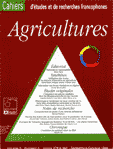Période optimale de récolte des tubercules de topinambour ("Helianthus tuberosus" L.) pour la production de fructose
Résumé
In the Kharkov and Violet de Rennes cultivars of the Jerusalem artichoke (Helianthus tuberosus L), the dry matter (DM) and total carbohydrates content of stalks and leaves decrease after flowering until stabilising at a minimum level just before maturity (for stalks :13 ± 1.4 g/100 g DM for Kharkov and 21.3 ± 0.5 g/100 g DM Violet de Rennes ; for leaves, the minimum was 0.6 ± 0.02 g/100 g DM for Kharkov and 0.7 ± 0.02 g/100 g DM for Violet de Rennes). During the period between flowering and maturity, the total carbohydrate content (fructose + glucose) of the tubers increased to reach a maximum of 71.3 ± 2.6 g/100 g DM for Kharkov, 75.3 ± 3.4 g/100 g DM for Violet de Rennes. The tubers lost a significant proportion of their carbohydrate content over winter. Losses between mid-November and end of March were assessed at 14.3 % for Kharkov and 17.8 % for Violet de Rennes. Since time of harvest markedly influences the Jerusalem artichoke fructose yield, it was concluded that tubers, as a source of carbohydrates (especially fructose), should not be harvested before maturity, i.e. mid-November for late cultivars such as Kharkov and Violet de Rennes.Publié
1994-09-01
Comment citer
Ben Chekroun, M. ., Amzile, J., El Haloui, N. E. ., & Prévost, J. (1994). Période optimale de récolte des tubercules de topinambour ("Helianthus tuberosus" L.) pour la production de fructose. Cahiers Agricultures, 3(5), 319–322 (1). Consulté à l’adresse https://revues.cirad.fr/index.php/cahiers-agricultures/article/view/29853
Numéro
Rubrique
Articles

